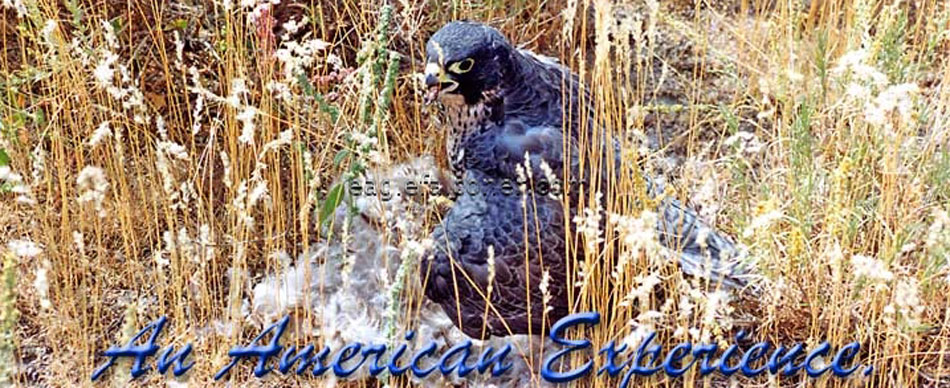"An American Experience."
BY
Alan Gates.
First Published in the Austringer 1996
The Department of the Environment’s Bird Registration Section, released the figure, a few years ago, of around 8,000 or so raptor keepers in the United Kingdom. Sadly the bulk of this number are aviculturists, pet keepers, circus-arena lure swingers and posers, with I guess a mere 500 or so, who are truly dedicated towards striving for excellence in the art of falconry. You may or may not, have some argument with my breakdown of the numbers, but I doubt that, if you are one of the dedicated, you will have never felt outnumbered by the the psudo-types. I put this point of view forward, as a possible illustration to help explain my long time passion for communicating with, and occasionally meeting, some of the truly great practising falconers of our time. I think it stems from my first steps into the art, at that time I already had a young hawk in my possession, when our town library divulged to me the fascinating world of falconry. I had to work hard to find any practitioners, and even harder still to convince them of my sincerity and dedication to warrant their valuable time. Most of this early communication was through letter writing, and as the years pass my letters continue to fly around the world. The desire to make contact and to learn from other falconers has never diminished. 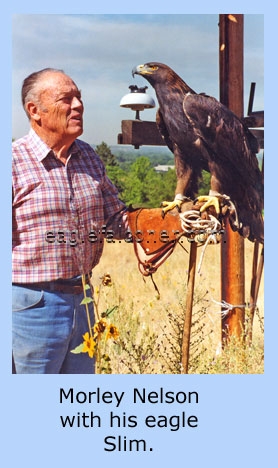 Maybe its a sign of the advancing years but these days I am more perceptive to the fact that if an idea gels and is worth doing, then there is no time like the present. For the past few years I have been enjoying an extended correspondence with Morlan Nelson, one of Americas great ambassadors for the right of birds of prey to fly in the skies, without every rancher and landowner reaching for a gun. It was Morlan’s work with eagles that first inspired my initial correspondence, but it soon grew both in frequency and depth of content. So much so that I felt the need for us both to sit around the table for a number of days and just talk eagles. As I mentioned before about ‘if an idea gels’, I booked a flight to the U.S. for early September with the prime objective of spending time with Morlan Nelson. His home is situated in the foothills of Boise the capitol of Idaho, this high desert region east of the Cascade Mountains is a magnet for serious US falconers, who wish to pursue the ultimate of game birds, the sage grouse, with their high flying, hard hitting hybrid falcons. With this in mind and to give Morlan a break from days of relentless questions, I also arranged to meet a few other falconers I knew of in the area. What started as casual planning soon gathered momentum, and before I knew it I was standing in the foyer of Boise airport. It was early evening but I was feeling the effect of loosing seven hours, and my body demanded a bed after twenty three hours travelling. The following morning my room resembled an untidy office as I rang around fixing dates on what had been a loosely planned schedule before I landed. My main priority was to contact Charles and Patty Browning who I had last spoken to by phone on Thanksgiving Day. Then the exact dates had been a bit hazy, but the invitation was offered to join them and a few friends at camp on the Camas Prairie to hawk ducks and grouse. Now Patty’s voice on the answer phone indicated they would be camped near Soldier creek just north of Fairfield, and gave a mobile number if the caller required more details. Well I bloody did, but I could not get an answer from the mobile for the best part of the morning. Finally Patty’s voice interrupted the phones ringing, she had moved out of the foothills that had been blocking the signal and was now out on the prairie hawking. I took her advice and cadged a lift from Boisian falconer Jon Neviaser who was driving down the following morning. We grabbed a drive in breakfast and proceeded along Interstate 84 slightly later than planned. Driving with large cups of scalding hot coffee in one hand and egg baps in the other, whilst talking falconry and swerving to identify the hawks sat on the cross bars of the power poles as Redtail, Swainsons, Ferruginous or Golden Eagles made the trip memorable. We had enormous difficulty translating Patty’s simple instructions on how to find the camp into reality, even the local Sheriff could not help. We had just returned to start at the Fairfield General Stores, when we both noticed that a Landcrusier that was been filled up at the gas pump and was carrying two fine hooded white gyr tiercel’s. We were getting warmer. It turned out to be Dan Thee, who gave us the welcome news that all the falconers Maybe its a sign of the advancing years but these days I am more perceptive to the fact that if an idea gels and is worth doing, then there is no time like the present. For the past few years I have been enjoying an extended correspondence with Morlan Nelson, one of Americas great ambassadors for the right of birds of prey to fly in the skies, without every rancher and landowner reaching for a gun. It was Morlan’s work with eagles that first inspired my initial correspondence, but it soon grew both in frequency and depth of content. So much so that I felt the need for us both to sit around the table for a number of days and just talk eagles. As I mentioned before about ‘if an idea gels’, I booked a flight to the U.S. for early September with the prime objective of spending time with Morlan Nelson. His home is situated in the foothills of Boise the capitol of Idaho, this high desert region east of the Cascade Mountains is a magnet for serious US falconers, who wish to pursue the ultimate of game birds, the sage grouse, with their high flying, hard hitting hybrid falcons. With this in mind and to give Morlan a break from days of relentless questions, I also arranged to meet a few other falconers I knew of in the area. What started as casual planning soon gathered momentum, and before I knew it I was standing in the foyer of Boise airport. It was early evening but I was feeling the effect of loosing seven hours, and my body demanded a bed after twenty three hours travelling. The following morning my room resembled an untidy office as I rang around fixing dates on what had been a loosely planned schedule before I landed. My main priority was to contact Charles and Patty Browning who I had last spoken to by phone on Thanksgiving Day. Then the exact dates had been a bit hazy, but the invitation was offered to join them and a few friends at camp on the Camas Prairie to hawk ducks and grouse. Now Patty’s voice on the answer phone indicated they would be camped near Soldier creek just north of Fairfield, and gave a mobile number if the caller required more details. Well I bloody did, but I could not get an answer from the mobile for the best part of the morning. Finally Patty’s voice interrupted the phones ringing, she had moved out of the foothills that had been blocking the signal and was now out on the prairie hawking. I took her advice and cadged a lift from Boisian falconer Jon Neviaser who was driving down the following morning. We grabbed a drive in breakfast and proceeded along Interstate 84 slightly later than planned. Driving with large cups of scalding hot coffee in one hand and egg baps in the other, whilst talking falconry and swerving to identify the hawks sat on the cross bars of the power poles as Redtail, Swainsons, Ferruginous or Golden Eagles made the trip memorable. We had enormous difficulty translating Patty’s simple instructions on how to find the camp into reality, even the local Sheriff could not help. We had just returned to start at the Fairfield General Stores, when we both noticed that a Landcrusier that was been filled up at the gas pump and was carrying two fine hooded white gyr tiercel’s. We were getting warmer. It turned out to be Dan Thee, who gave us the welcome news that all the falconers 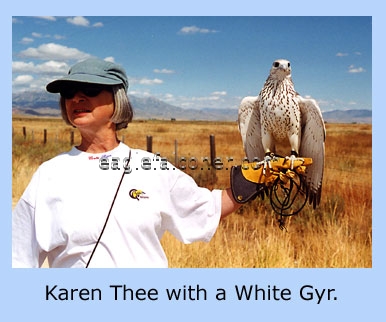 were meeting at the Stores prior to heading out on the prairie hawking. Within minutes we were surrounded by four wheel drives, dogs, falcons and too many introductions for my brain to take in, and we were back on the road in convoy It was ten a.m. on a normal September day in Idaho, the temperature was heading for its daily peak of the low nineties and the sky, with not a cloud to be found which stretched for miles, was a deep blue. The convoy stopped along a dusty road, we were just south of the Soldier mountains on the Camas Prairie. Rob Holen was kitted up ready to fly his falcon, and proceeded out into the sage bush and cheat grass, the organisation was loose, not everyone was ready, some stayed with the vehicles. I headed out to catch up with the two or three falconers with Rob, who by now had removed the hood and held aloft his fine Gyr x Peregrine ‘Vapour’. It leant into the slight breeze and pushed off the fist, a quick rouse and she was soon pumping into the sky. In no time I was having difficulty in keeping her in my 8 x 30’s, having reached her pitch she turned and headed over Rob who was now moving towards a pond. With no undulation in the ground I had not seen this pond, these guys had been here before. A labrador and pointer set off for the water, and a group of small ducks flushed from the edge of the reed grass, I looked skywards, the falcon had teardropped and was stooping, I looked back to find the ducks, and just located them when the air was torn apart as the falcon levelled out and tapped the lead duck in the head. It dropped stone dead. She rolled over and landed with her prize. Next to put a were meeting at the Stores prior to heading out on the prairie hawking. Within minutes we were surrounded by four wheel drives, dogs, falcons and too many introductions for my brain to take in, and we were back on the road in convoy It was ten a.m. on a normal September day in Idaho, the temperature was heading for its daily peak of the low nineties and the sky, with not a cloud to be found which stretched for miles, was a deep blue. The convoy stopped along a dusty road, we were just south of the Soldier mountains on the Camas Prairie. Rob Holen was kitted up ready to fly his falcon, and proceeded out into the sage bush and cheat grass, the organisation was loose, not everyone was ready, some stayed with the vehicles. I headed out to catch up with the two or three falconers with Rob, who by now had removed the hood and held aloft his fine Gyr x Peregrine ‘Vapour’. It leant into the slight breeze and pushed off the fist, a quick rouse and she was soon pumping into the sky. In no time I was having difficulty in keeping her in my 8 x 30’s, having reached her pitch she turned and headed over Rob who was now moving towards a pond. With no undulation in the ground I had not seen this pond, these guys had been here before. A labrador and pointer set off for the water, and a group of small ducks flushed from the edge of the reed grass, I looked skywards, the falcon had teardropped and was stooping, I looked back to find the ducks, and just located them when the air was torn apart as the falcon levelled out and tapped the lead duck in the head. It dropped stone dead. She rolled over and landed with her prize. Next to put a 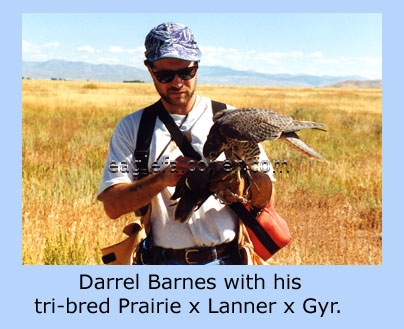 falcon to the sky was Darryl Barnes with a lovely tri-bred Prairie x Lanner x Gyr which was climbing almost from the fist and was soon just a speck in the heavens. The pattern followed as before from the same pond, it had a good area of cover with the surrounding reed bed, which held pockets of ducks who quite obligingly stayed put until flushed and enabled repeated flights all morning. The dogs flushed a small group of ducks and the tri-bred was soon ripping though them, a very experienced falcon she knew that a head hit meant certain death in the air, her victim was a Shoveler duck and was soon in the bag. Charles Browning soon had ‘Zorro’ his strikingly marked tiercel Gyr x Peregrine high over the pond, ‘Zorro’ like all the falcons flown was super fit by any standards let alone this early into the season. At one point I watched as Charles joined the dogs wading in the water to successfully flush ducks for his waiting teircel. ‘Zorro’ too took a Shoveler duck, these falcons made it look easy, and in doing so concealed the skill and experience of each of these falconer / falcon teams. We left the pond to settle down and returned to the vehicles to quench our thirst and partake of a little food. The heat of the day was reaching its peak, or at least I’d hoped it was. The discussion between the falconers reached a consensus that Charles would take his Golden Eagle ‘Messiah’ up into the foothills where he would hopefully find some lift, thus leaving the remaining falcons in the shade awaiting the cooler evening air in which to continue flying on the flat prairie. Watching these superb falcons been flown was an unexpected treat for me, but to experience the techniques of one of the few American eagle falconers, was the number one reason I had travelled to the west. Charles carrying a hooded ‘Messiah’ climbed the hill, as I followed my footsteps disturbed the dry dusty soil. The gravelled lava rock in places was like marbles under your feet, together with the long woody stems of sage bush lurking close to the ground just waiting to trip the unexpected footstep, made me aware that I lacked the aid of my trusty thumb stick. I was feeling the effects of a lazy summer, Charles on the other hand was finally tuned. I watched as he strode up the hill a little ahead of me, the muscles of his bare legs pushing like pistons as they brushed aside the sage. This was not the start of the season for Charles and ‘Messiah’, as they had kept flying throughout the moult and successfully taken many blacktails. We stopped at about three hundred feet up the hill, the view out across the prairie was dramatic and I was surprised to see about fifteen ponds scattered about in front of us. The one we had been working the falcons over that morning was by far the largest. As our breathing pattern returned to normal, Charles removed the eagles hood. falcon to the sky was Darryl Barnes with a lovely tri-bred Prairie x Lanner x Gyr which was climbing almost from the fist and was soon just a speck in the heavens. The pattern followed as before from the same pond, it had a good area of cover with the surrounding reed bed, which held pockets of ducks who quite obligingly stayed put until flushed and enabled repeated flights all morning. The dogs flushed a small group of ducks and the tri-bred was soon ripping though them, a very experienced falcon she knew that a head hit meant certain death in the air, her victim was a Shoveler duck and was soon in the bag. Charles Browning soon had ‘Zorro’ his strikingly marked tiercel Gyr x Peregrine high over the pond, ‘Zorro’ like all the falcons flown was super fit by any standards let alone this early into the season. At one point I watched as Charles joined the dogs wading in the water to successfully flush ducks for his waiting teircel. ‘Zorro’ too took a Shoveler duck, these falcons made it look easy, and in doing so concealed the skill and experience of each of these falconer / falcon teams. We left the pond to settle down and returned to the vehicles to quench our thirst and partake of a little food. The heat of the day was reaching its peak, or at least I’d hoped it was. The discussion between the falconers reached a consensus that Charles would take his Golden Eagle ‘Messiah’ up into the foothills where he would hopefully find some lift, thus leaving the remaining falcons in the shade awaiting the cooler evening air in which to continue flying on the flat prairie. Watching these superb falcons been flown was an unexpected treat for me, but to experience the techniques of one of the few American eagle falconers, was the number one reason I had travelled to the west. Charles carrying a hooded ‘Messiah’ climbed the hill, as I followed my footsteps disturbed the dry dusty soil. The gravelled lava rock in places was like marbles under your feet, together with the long woody stems of sage bush lurking close to the ground just waiting to trip the unexpected footstep, made me aware that I lacked the aid of my trusty thumb stick. I was feeling the effects of a lazy summer, Charles on the other hand was finally tuned. I watched as he strode up the hill a little ahead of me, the muscles of his bare legs pushing like pistons as they brushed aside the sage. This was not the start of the season for Charles and ‘Messiah’, as they had kept flying throughout the moult and successfully taken many blacktails. We stopped at about three hundred feet up the hill, the view out across the prairie was dramatic and I was surprised to see about fifteen ponds scattered about in front of us. The one we had been working the falcons over that morning was by far the largest. As our breathing pattern returned to normal, Charles removed the eagles hood. 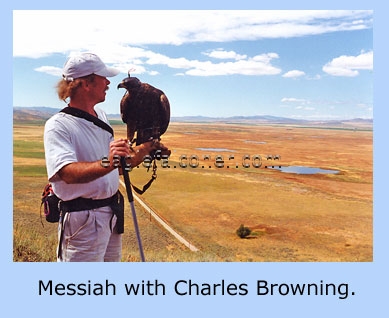 The slight breeze that was blowing gave the eagle little advantage, as it came across and down the hill from behind us. As Charles extended his arm the eagle spread his wings, dropping altitude down the hill he then circled a little way out only to return and land. I know the feeling well, on your own and with the elements, the eagle and luck on your side it can be the recipe for a red letter day. With the expecting assembled crowd down below and the wind as flat as a f**t. Things did not look as though the eagle was about to burn any primaries. Once or twice the eagle did a circuit as though looking for lift, then as we were slowly moving down the hill ‘Messiah’ found a very gentle thermal of warm air. In seconds the efficiency of those large broad wings soon had the eagle above us, within a couple of minutes he was high above the hills. Charles and I hurried down the hill to the flat prairie below, all the time stopping to locate ‘Messiahs’ position in the sky, who was now over the second hill ridge. By the time we were both on the flat the eagle was just a speck, I stayed put whilst Charles moved out into the prairie, then he would locate ‘Messiah’ and I could then join him. The eagle was now so high he was lost to the naked eye, we had to hand over his position to one another before you could take down your binoculars and walk out into the prairie. We continued our progress in this relay The slight breeze that was blowing gave the eagle little advantage, as it came across and down the hill from behind us. As Charles extended his arm the eagle spread his wings, dropping altitude down the hill he then circled a little way out only to return and land. I know the feeling well, on your own and with the elements, the eagle and luck on your side it can be the recipe for a red letter day. With the expecting assembled crowd down below and the wind as flat as a f**t. Things did not look as though the eagle was about to burn any primaries. Once or twice the eagle did a circuit as though looking for lift, then as we were slowly moving down the hill ‘Messiah’ found a very gentle thermal of warm air. In seconds the efficiency of those large broad wings soon had the eagle above us, within a couple of minutes he was high above the hills. Charles and I hurried down the hill to the flat prairie below, all the time stopping to locate ‘Messiahs’ position in the sky, who was now over the second hill ridge. By the time we were both on the flat the eagle was just a speck, I stayed put whilst Charles moved out into the prairie, then he would locate ‘Messiah’ and I could then join him. The eagle was now so high he was lost to the naked eye, we had to hand over his position to one another before you could take down your binoculars and walk out into the prairie. We continued our progress in this relay 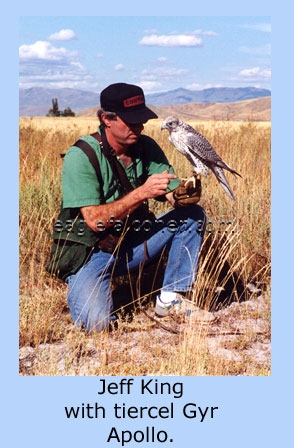 fashion moving towards the larger pond, Charles was hoping for a stoop at ducks. The eagle was a good mile away and hundreds of feet above a second ridge of hills, he was riding the air drafts back and forth for about three quarters of a mile along the ridge of hills. At one point a wild eagle joined him, and I became confused as which was our bird, Charles knew and was proved right when the eagle I was watching disappeared into the blue and ‘Messiah’ finally started to fly towards the prairie still keeping the height gained. With my aching arms, a sunburnt face and hour later ‘Messiah’ was high above us and we were ready to flush the pond, by now everyone had joined us and a mass flush was on hand. Dogs, children and falconers pushed forward, a shout, someone called out “Messiah was stooping’, from what must have been well over a thousand feet came a stooping eagle in a style that any falcon would have been proud to match. A small flock of ducks had left the water and looked to be making for the next pond, one of them must have spotted the eagle and they all hit the water like a shower of stones. At about three hundred feet he terminated his stoop and levelled out, cutting across the sky with the accelerated velocity he had gained. Over flying the pond he turned then rolled over and stooped to the ground. As we made our way round the pond edge towards where ‘Messiah’ had landed, a wild eagle came low in from behind us and shot straight into where ‘Messiah’ was. Panic broke out as everyone rushed forward, mud splashed every where as most of us took the direct route. As we approached to where the two eagles were it was ‘Messiah’ who took off first, we were almost on top of the wild eagle (a first year bird) before it left. ‘Messiah’ had taken a coot running across the mud flat, and to the young eagle ‘Messiah’ possibly reminded it of its parent, came in for a feed. With no harm done, Charles called ‘Messiah’ down to a well earned reward. The late afternoon was spent with Rob Holen and Jeff King’s gyr’s hawking sage grouse. As dusk crept in and rob picked up his young gyr on a grouse kill, the sound of coyotes howling to one another across the hills brought a superb finale to a magnificent days Hawking the Camas in America’s Northwest. Jon and I returned to Boise and to his home in the northern foothills, where he had so kindly invited me to spend a few days with him and his lovely wife ‘Wanda’ and their young son ‘Nathan’. The lucky so and so had procured a job with The Raptor Research Centre of Boise States University. Jon’s work involved a study into what raptors see, this was supported by KENETECH Windpower, Inc. as they were concerned by the occasional raptor collision with wind turbine blades. He was maintaining, training and flying a number of Red-tailed hawks and American kestrels. These were housed in a facility at Zoo Boise and were flown out of town at a wind turbine field, the study hoped to find some marking or patterning effect that would make the moving turbine blades more visible to flying raptors. It had been an extraordinary coincidence meeting Jon Neviaser in Boise, when his name had been suggested to me by Patty Browning I had that déjà vu feeling. The name rang bells, and as it turned out it was the right man in the wrong place. Well that was due to the incorrect data stored in my brain. Jon had been logged in the brain cells, as a falconer to write to, because he was the only falconer that I had every heard of to be flying Ornate Hawk Eagles. Where things did not compute, I had Jon logged as living in Virginia. Whilst behind my back he had moved family and chattels and relocated in this falconers paradise. Stranger still, who should live next door, none other than Kent Carnie, falconer and Curator of the Archives of American Falconry. I had corresponded with Kent before leaving England and made arrangements to visit the fashion moving towards the larger pond, Charles was hoping for a stoop at ducks. The eagle was a good mile away and hundreds of feet above a second ridge of hills, he was riding the air drafts back and forth for about three quarters of a mile along the ridge of hills. At one point a wild eagle joined him, and I became confused as which was our bird, Charles knew and was proved right when the eagle I was watching disappeared into the blue and ‘Messiah’ finally started to fly towards the prairie still keeping the height gained. With my aching arms, a sunburnt face and hour later ‘Messiah’ was high above us and we were ready to flush the pond, by now everyone had joined us and a mass flush was on hand. Dogs, children and falconers pushed forward, a shout, someone called out “Messiah was stooping’, from what must have been well over a thousand feet came a stooping eagle in a style that any falcon would have been proud to match. A small flock of ducks had left the water and looked to be making for the next pond, one of them must have spotted the eagle and they all hit the water like a shower of stones. At about three hundred feet he terminated his stoop and levelled out, cutting across the sky with the accelerated velocity he had gained. Over flying the pond he turned then rolled over and stooped to the ground. As we made our way round the pond edge towards where ‘Messiah’ had landed, a wild eagle came low in from behind us and shot straight into where ‘Messiah’ was. Panic broke out as everyone rushed forward, mud splashed every where as most of us took the direct route. As we approached to where the two eagles were it was ‘Messiah’ who took off first, we were almost on top of the wild eagle (a first year bird) before it left. ‘Messiah’ had taken a coot running across the mud flat, and to the young eagle ‘Messiah’ possibly reminded it of its parent, came in for a feed. With no harm done, Charles called ‘Messiah’ down to a well earned reward. The late afternoon was spent with Rob Holen and Jeff King’s gyr’s hawking sage grouse. As dusk crept in and rob picked up his young gyr on a grouse kill, the sound of coyotes howling to one another across the hills brought a superb finale to a magnificent days Hawking the Camas in America’s Northwest. Jon and I returned to Boise and to his home in the northern foothills, where he had so kindly invited me to spend a few days with him and his lovely wife ‘Wanda’ and their young son ‘Nathan’. The lucky so and so had procured a job with The Raptor Research Centre of Boise States University. Jon’s work involved a study into what raptors see, this was supported by KENETECH Windpower, Inc. as they were concerned by the occasional raptor collision with wind turbine blades. He was maintaining, training and flying a number of Red-tailed hawks and American kestrels. These were housed in a facility at Zoo Boise and were flown out of town at a wind turbine field, the study hoped to find some marking or patterning effect that would make the moving turbine blades more visible to flying raptors. It had been an extraordinary coincidence meeting Jon Neviaser in Boise, when his name had been suggested to me by Patty Browning I had that déjà vu feeling. The name rang bells, and as it turned out it was the right man in the wrong place. Well that was due to the incorrect data stored in my brain. Jon had been logged in the brain cells, as a falconer to write to, because he was the only falconer that I had every heard of to be flying Ornate Hawk Eagles. Where things did not compute, I had Jon logged as living in Virginia. Whilst behind my back he had moved family and chattels and relocated in this falconers paradise. Stranger still, who should live next door, none other than Kent Carnie, falconer and Curator of the Archives of American Falconry. I had corresponded with Kent before leaving England and made arrangements to visit the 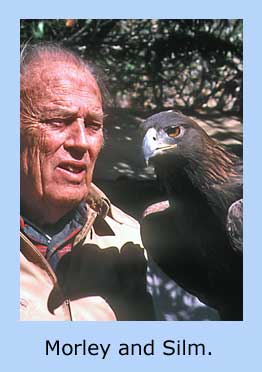 Archives. If like me you have a fascination for falconry art and literature, here is the largest and most accessible collection in the world. I spent two days combing through manuscripts, books, journals and personal papers and letters of some of the greatest American and British falconers. This collection is a jewel in the crown of American falconry, it was created by the Peregrine Fund and is housed at its headquarters at the World Centre for Birds of Prey. It is supported solely by donations much of which comes from the individual American Falconer. Meticulously kept and collated by Lieutenant Colonel (Ret.) S.Kent Carnie, U.S. Army, who has been personally acquainted with many of the key historical figures of American falconry. Clearly Kent loves his work, ‘every day is like Christmas, when I open the mail each morning’ he told me. As I searched the old falconry journals, shouts of delight came from Kent as old black and white photographs slipped from newly opened envelopes. As I looked over his shoulder he named the faces, some mentors, some just acquaintances, many friends and many memories. I glanced out of the large window in front of Kent’s desk as he talked, the large expanse of dried cheat grass rolled down the hill, golden honey brown in the morning sunlight. Just then an immature Golden Eagle flew past not one hundred yards from Kent’s desk,” God dam it, if ever you need an assistant Kent, I’m just one phone call away”. Later on the second day at the Archives, Cal Sandfort of the World Centre offered to take me on a personal tour of the falcon factory. Although the breeding season was over, one got an excellent impression and no doubt a more detailed insight into the work of the Peregrine Fund. Cal is a dedicated, highly experienced falcon breeder, and as part of the ‘P’ Fund’s team he can justifiable be proud of their success. The Peregrine Fund was established in 1970 by Professor Tom Cade at Cornell, after the widespread use of DDT and other chlorinated hydrocarbon pesticides, peregrine numbers in the United States plummeted during the 1950’s and 60’s. By the end of the 60’s the peregrine was extinct in the Eastern United States and reduced by 90% in the West. Alarmed by this situation Cade and other eminent falconers developed a method of breeding peregrines in captivity, together with pioneering successful methods for the release of the captive bred falcons to the wild, made this the most successful breeding and progeny release conservation program of the 20th century. To date the Fund has released over 4,000 captive bred falcons in 28 states, the Peregrine is well and truly saved in the United States and has been down listed from Endangered. Strangely enough, I think the one thing that brought home to me the enormity of the project was a visit to the falcon food breeding centre. 120,000 quail are needed to feed the falcons and standing in front of a hopper that must of held some 10,000 frozen quail, one gets to understand the logistics and enormous amount of work involved to succeed at such a scale. It made me proud to know that falconers have achieved the largest and most successful captive breeding and release project of an endangered species, anywhere on the globe. With the completion of the Peregrine restoration program the Centre is concentrating its efforts on other species such as the Aplomado Falcon, California Condor and the Harpy Eagle. All are breeding at the Centre with the intention, as is happening with the Aplomado falcon of Archives. If like me you have a fascination for falconry art and literature, here is the largest and most accessible collection in the world. I spent two days combing through manuscripts, books, journals and personal papers and letters of some of the greatest American and British falconers. This collection is a jewel in the crown of American falconry, it was created by the Peregrine Fund and is housed at its headquarters at the World Centre for Birds of Prey. It is supported solely by donations much of which comes from the individual American Falconer. Meticulously kept and collated by Lieutenant Colonel (Ret.) S.Kent Carnie, U.S. Army, who has been personally acquainted with many of the key historical figures of American falconry. Clearly Kent loves his work, ‘every day is like Christmas, when I open the mail each morning’ he told me. As I searched the old falconry journals, shouts of delight came from Kent as old black and white photographs slipped from newly opened envelopes. As I looked over his shoulder he named the faces, some mentors, some just acquaintances, many friends and many memories. I glanced out of the large window in front of Kent’s desk as he talked, the large expanse of dried cheat grass rolled down the hill, golden honey brown in the morning sunlight. Just then an immature Golden Eagle flew past not one hundred yards from Kent’s desk,” God dam it, if ever you need an assistant Kent, I’m just one phone call away”. Later on the second day at the Archives, Cal Sandfort of the World Centre offered to take me on a personal tour of the falcon factory. Although the breeding season was over, one got an excellent impression and no doubt a more detailed insight into the work of the Peregrine Fund. Cal is a dedicated, highly experienced falcon breeder, and as part of the ‘P’ Fund’s team he can justifiable be proud of their success. The Peregrine Fund was established in 1970 by Professor Tom Cade at Cornell, after the widespread use of DDT and other chlorinated hydrocarbon pesticides, peregrine numbers in the United States plummeted during the 1950’s and 60’s. By the end of the 60’s the peregrine was extinct in the Eastern United States and reduced by 90% in the West. Alarmed by this situation Cade and other eminent falconers developed a method of breeding peregrines in captivity, together with pioneering successful methods for the release of the captive bred falcons to the wild, made this the most successful breeding and progeny release conservation program of the 20th century. To date the Fund has released over 4,000 captive bred falcons in 28 states, the Peregrine is well and truly saved in the United States and has been down listed from Endangered. Strangely enough, I think the one thing that brought home to me the enormity of the project was a visit to the falcon food breeding centre. 120,000 quail are needed to feed the falcons and standing in front of a hopper that must of held some 10,000 frozen quail, one gets to understand the logistics and enormous amount of work involved to succeed at such a scale. It made me proud to know that falconers have achieved the largest and most successful captive breeding and release project of an endangered species, anywhere on the globe. With the completion of the Peregrine restoration program the Centre is concentrating its efforts on other species such as the Aplomado Falcon, California Condor and the Harpy Eagle. All are breeding at the Centre with the intention, as is happening with the Aplomado falcon of 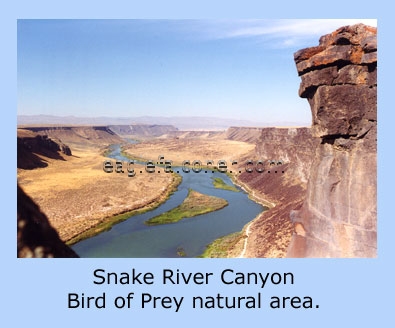 releasing progeny into its natural habitat. When I had first arrived in Boise I telephoned Morlan Nelson to arrange my schedule, he suggested that I look in at the World Centre first, to see the showcase that is dedicated to some of his life. This I duly did as part of the official tour of its ‘Interpretative Centre’. On display was Morlan’s first conservation tool, his holstered hand gun. Returning from the War Morlan continued to fly falcons and make 8 mm films of them, but so many people stopped to shoot at his falcon if it landed on a power pole that he started to carry a Colt frontier model six gun to fire in their direction if they attempted to shoot at his falcon. This wild west action saved many of his falcons lives but it nearly started a war in the state of Utah where he lived. So many individuals believed that all chicken hawks, bullet hawks and duck hawks should be shot on sight, and this caused many a heated argument which nearly ended in a shoot out. It became clear to Morlan that the way forward was through education not the bullet. Walt Disney, having seen Morlan’s early 8 mm movies of his falcons brought him to Hollywood as a consultant on early wildlife adventures as ‘The Living Desert’ and ‘The Vanishing Prairie’ . Morlan flew Red tail hawks and Prairie Falcons, which gave many Americans their first intimate sight of wild birds of prey. The effects of the Disney films and the six series of TV’s “Wild Kingdom” which Morlan worked on had such a dramatic effect on the American public perception of wild birds of prey, now you hardly ever hear the words, “chicken hawk” used. Also on show were Morlan's war medals, he had given them to the Centre as he felt that their possession by him was morally wrong and they should have been awarded to his fallen comrades. As an officer in the legendary Tenth Mountain Division, the all-volunteer ski troops, Morlan saw action from the Aleutians to the Battle of Brenner Pass. Decorated with the Silver Star and Purple Heart and wounded in the final week of hostility, but languishing in a hospital bed with his leg in a cast was not to stop Morlan from a successful attempt to obtain a young kestrel he had been watching on a nearby cliff. It involved rappelling down a cliff, but he returned to the hospital with the kestrel, a broken cast and some unexplained rope burns on his pyjamas. I was beginning to understand the enormity of the task ahead of me in trying to document much of Morlan Nelson’s life. His long life right from a boy growing up on a North Dakota ranch has been dedicated to the education of the American people towards the conservation of its birds of prey. My real interest in Morlan Nelson was his work with eagles, and predominately the Golden Eagle. Although Morlan has worked with Bald, Bateleur and Harpy eagles, it is his work with golden eagles which is so extensive and of such great interest to me. We talked for days, and Morlan demonstrated many of his techniques often using his female golden eagle to model a particular releasing progeny into its natural habitat. When I had first arrived in Boise I telephoned Morlan Nelson to arrange my schedule, he suggested that I look in at the World Centre first, to see the showcase that is dedicated to some of his life. This I duly did as part of the official tour of its ‘Interpretative Centre’. On display was Morlan’s first conservation tool, his holstered hand gun. Returning from the War Morlan continued to fly falcons and make 8 mm films of them, but so many people stopped to shoot at his falcon if it landed on a power pole that he started to carry a Colt frontier model six gun to fire in their direction if they attempted to shoot at his falcon. This wild west action saved many of his falcons lives but it nearly started a war in the state of Utah where he lived. So many individuals believed that all chicken hawks, bullet hawks and duck hawks should be shot on sight, and this caused many a heated argument which nearly ended in a shoot out. It became clear to Morlan that the way forward was through education not the bullet. Walt Disney, having seen Morlan’s early 8 mm movies of his falcons brought him to Hollywood as a consultant on early wildlife adventures as ‘The Living Desert’ and ‘The Vanishing Prairie’ . Morlan flew Red tail hawks and Prairie Falcons, which gave many Americans their first intimate sight of wild birds of prey. The effects of the Disney films and the six series of TV’s “Wild Kingdom” which Morlan worked on had such a dramatic effect on the American public perception of wild birds of prey, now you hardly ever hear the words, “chicken hawk” used. Also on show were Morlan's war medals, he had given them to the Centre as he felt that their possession by him was morally wrong and they should have been awarded to his fallen comrades. As an officer in the legendary Tenth Mountain Division, the all-volunteer ski troops, Morlan saw action from the Aleutians to the Battle of Brenner Pass. Decorated with the Silver Star and Purple Heart and wounded in the final week of hostility, but languishing in a hospital bed with his leg in a cast was not to stop Morlan from a successful attempt to obtain a young kestrel he had been watching on a nearby cliff. It involved rappelling down a cliff, but he returned to the hospital with the kestrel, a broken cast and some unexplained rope burns on his pyjamas. I was beginning to understand the enormity of the task ahead of me in trying to document much of Morlan Nelson’s life. His long life right from a boy growing up on a North Dakota ranch has been dedicated to the education of the American people towards the conservation of its birds of prey. My real interest in Morlan Nelson was his work with eagles, and predominately the Golden Eagle. Although Morlan has worked with Bald, Bateleur and Harpy eagles, it is his work with golden eagles which is so extensive and of such great interest to me. We talked for days, and Morlan demonstrated many of his techniques often using his female golden eagle to model a particular 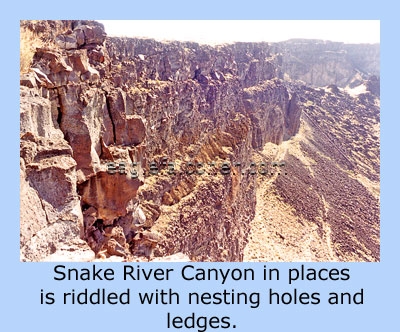 hood or to show me how he applied the snap fit jesses he developed for his film work. Not all of our discussions were of the armchair variety, Morlan enthusiastically guided me on trips to the Boise River Canyon and the famous Snake River Canyon. The night before our planned trip to the Snake River Canyon, Morlan announced that he would take a rope along, so we could go over the edge and I could have a better view point for photographing the canyon. ‘WE’ could go over the edge of the canyon, never one to make much of a point as to how much of a wimp this Englishman might be, I kept my mouth shut. This coupled with the loose talk of sun basking diamond backed rattlesnakes, had the effect of concentrating the mind. If fact I was conscious of where I was placing my feet in this hot arid dessert landscape, I had no intention of disturbing the slumbers of any ten foot diamond back, No siree. As we walked, Morlan pointed out many new and disused eyries of Golden Eagles and Prairie Falcons, in this remote and desolate canyon which at first glance is like many desert, river and cliff complexes in the North Western United States. It was not until Morlan Nelson moved to live in Boise, Idaho that he discovered that the Swan Falls area of the Snake River to be a very unique habitat, probably in the United States if not in the world. It was though Morlan's work as a soil scientist and hydrologist employed by the U.S. Department of Agriculture’s Soil Conservation Service, that he discovered the condition of the top soil surrounding the top of the canyon. This deep, medium textured soil was perfect for the burrows of the Townsend ground squirrel who multiplied in the area in large numbers. Morlan also discovered that up to ten per cent of the nesting prairie falcons in the United States live in this unique 33 mile stretch of the Snake River Canyon, and that the Townsend ground squirrel made up to 70 per cent of the falcons diet. Forty nine pairs of prairie falcons nested in the Swan Falls area, which means there was a falcons nest every 300-400 yards in the canyon. Morlan also found that this area of South Western Idaho contained about 100 Golden Eagle eyrie's, probably the largest concentration in North America and possible the world. He brought this unique location into the living rooms of millions of Americans through two nationally televised films that he worked on, Disney’s “Ida the Off-Beat Eagle” and the Wild Kingdom series, “The Valley of the Eagles”. Through an enormous amount of lobbying, Morlan brought the uniqueness of this priceless heritage to the attention of the Department of the Interior, and upon the recommendation of the Bureau of Land Management, a protective withdrawal of 26,255 acres of land along the Swan Falls reach of the river was designated a “Nature Area” a unique and exceptional sanctuary for rare birds of prey, now known as the Snake River Birds of Prey Natural Area. In April of 1972, a new effort to increase consideration for eagles was spearheaded by the Idaho Power Company. It had found a problem with eagle electrocutions, the eagles often use power poles as landing sites from which to scan the surrounding terrain for game. A wingspan from six to eight feet makes it easy for a landing eagle to simultaneously touch the two phase conductors ( or one phase conductor and a ground wire) on either end of the crossarm. More and more eagles were being found under the company’s power lines, victims not only of the electricity but of gunshots, poison and starvation. Although the power company was unable to do anything about the last three things, it felt it might be able to prevent the electrocutions, but it wasn't sure how. Morlan Nelson now recognised as one of the world’s foremost authorities on eagles, hawks and other birds of prey was enlisted to help with Idaho Power engineers and biologists to study the problem of eagles and power lines. Idaho Power line crews built mock-ups of various types of poles in Nelson’s backyard in the foothills near Boise so he could study the eagles behaviour around the poles. Using his skills as a cinematographer, Morlan Nelson spent hundreds of hours filming his trained eagles in 16 mm slow motion on the mock-ups. The big birds were tested in a variety of wind conditions and the films provided dramatic proof of an eagle’s ability to touch both conductors with its hood or to show me how he applied the snap fit jesses he developed for his film work. Not all of our discussions were of the armchair variety, Morlan enthusiastically guided me on trips to the Boise River Canyon and the famous Snake River Canyon. The night before our planned trip to the Snake River Canyon, Morlan announced that he would take a rope along, so we could go over the edge and I could have a better view point for photographing the canyon. ‘WE’ could go over the edge of the canyon, never one to make much of a point as to how much of a wimp this Englishman might be, I kept my mouth shut. This coupled with the loose talk of sun basking diamond backed rattlesnakes, had the effect of concentrating the mind. If fact I was conscious of where I was placing my feet in this hot arid dessert landscape, I had no intention of disturbing the slumbers of any ten foot diamond back, No siree. As we walked, Morlan pointed out many new and disused eyries of Golden Eagles and Prairie Falcons, in this remote and desolate canyon which at first glance is like many desert, river and cliff complexes in the North Western United States. It was not until Morlan Nelson moved to live in Boise, Idaho that he discovered that the Swan Falls area of the Snake River to be a very unique habitat, probably in the United States if not in the world. It was though Morlan's work as a soil scientist and hydrologist employed by the U.S. Department of Agriculture’s Soil Conservation Service, that he discovered the condition of the top soil surrounding the top of the canyon. This deep, medium textured soil was perfect for the burrows of the Townsend ground squirrel who multiplied in the area in large numbers. Morlan also discovered that up to ten per cent of the nesting prairie falcons in the United States live in this unique 33 mile stretch of the Snake River Canyon, and that the Townsend ground squirrel made up to 70 per cent of the falcons diet. Forty nine pairs of prairie falcons nested in the Swan Falls area, which means there was a falcons nest every 300-400 yards in the canyon. Morlan also found that this area of South Western Idaho contained about 100 Golden Eagle eyrie's, probably the largest concentration in North America and possible the world. He brought this unique location into the living rooms of millions of Americans through two nationally televised films that he worked on, Disney’s “Ida the Off-Beat Eagle” and the Wild Kingdom series, “The Valley of the Eagles”. Through an enormous amount of lobbying, Morlan brought the uniqueness of this priceless heritage to the attention of the Department of the Interior, and upon the recommendation of the Bureau of Land Management, a protective withdrawal of 26,255 acres of land along the Swan Falls reach of the river was designated a “Nature Area” a unique and exceptional sanctuary for rare birds of prey, now known as the Snake River Birds of Prey Natural Area. In April of 1972, a new effort to increase consideration for eagles was spearheaded by the Idaho Power Company. It had found a problem with eagle electrocutions, the eagles often use power poles as landing sites from which to scan the surrounding terrain for game. A wingspan from six to eight feet makes it easy for a landing eagle to simultaneously touch the two phase conductors ( or one phase conductor and a ground wire) on either end of the crossarm. More and more eagles were being found under the company’s power lines, victims not only of the electricity but of gunshots, poison and starvation. Although the power company was unable to do anything about the last three things, it felt it might be able to prevent the electrocutions, but it wasn't sure how. Morlan Nelson now recognised as one of the world’s foremost authorities on eagles, hawks and other birds of prey was enlisted to help with Idaho Power engineers and biologists to study the problem of eagles and power lines. Idaho Power line crews built mock-ups of various types of poles in Nelson’s backyard in the foothills near Boise so he could study the eagles behaviour around the poles. Using his skills as a cinematographer, Morlan Nelson spent hundreds of hours filming his trained eagles in 16 mm slow motion on the mock-ups. The big birds were tested in a variety of wind conditions and the films provided dramatic proof of an eagle’s ability to touch both conductors with its 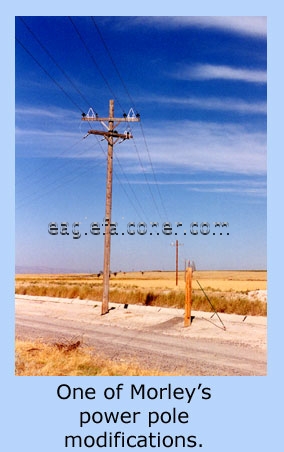 wing tips. A study of Idaho power pole landing sites determined that 95% of the electrocutions could be prevented by correcting 2% to 15% of the poles. This is due to the eagle’s extreme selectivity in choosing a landing site. Prevailing winds, prey density and surrounding topography have to be exactly right. The corrections made by the Idaho Power Company varied from covering conductors and raising one wire to building perches on top of the poles. The sometimes fatal attraction of some species of birds of prey to nesting on power structures carrying 69,000 volts resulted in the Idaho Power Company’s co-operation in designing nesting platforms for the larger birds , especially eagles. The idea for this platform came when Nelson observed a pair of golden eagles nesting on the observation tower from which the Idaho Air National Guard marks bomb hits from fighter planes in training pilots. The tower was an ideal nest, providing shade, elevation and protection from the wind. The nesting platform is mounted on a power structure, the open or unshaded end must be away from the tower. This gives the adults maximum freedom to land under all wind conditions. The Company stipulated that these nesting platforms should be constructed of materials impervious to weathering and have a projected lifespan equal to that of the power pole- approximately 100 years. Sturdy, permanent structures would not only minimise maintenance and replacement costs but would be of greater advantage to the birds. The success of these corrective modifications was documented in slow-motion photography. After correction, the poles became positive ecological factors rather than inviting, but lethal killers. It has been estimated that the work done to the Idaho Power Company’s poles following Morlan Nelson’s advice, which has been copied by other power companies within the western US, has saved the lives of around 300 eagles each year. The work on the power line problem lasted over a decade and Morlan’s own film company ‘Tundra Films’, filmed and produced the award winning film “Silver Wires, Golden Wings” which won top honours in four national film festivals. Nelson’s work on the thousands of modified power poles and nest platforms have actually benefited the eagles and other raptors. While there’s a solid prey base for raptors in the treeless high deserts of the western United Sates, high places which can be used for nest building and hunting perches are scarce. The building of power lines across the nation has undoubtedly helped raptors to increase their geographic distribution. With a life time dedicated to the promotion of the protection and better understanding of birds of prey, Morlan Nelson is The Man who saved the Eagles. When the time came for our goodbyes, it was a tough parting, I just wanted to stay a few more days. As Morlan put it, ‘We are looking at things from the same track’, all I can say is that it is a pleasure and an honour to know you Morlan Nelson. Back in downtown Boise with a couple of days before my return flight, I had made arrangements to meet just one more of the dedicated. Sometime back I had purchased a back issue of a NAFA Journal and the eloquent writing of Bruce Haak in his article entitled ‘Kudos For Kudo’ had wing tips. A study of Idaho power pole landing sites determined that 95% of the electrocutions could be prevented by correcting 2% to 15% of the poles. This is due to the eagle’s extreme selectivity in choosing a landing site. Prevailing winds, prey density and surrounding topography have to be exactly right. The corrections made by the Idaho Power Company varied from covering conductors and raising one wire to building perches on top of the poles. The sometimes fatal attraction of some species of birds of prey to nesting on power structures carrying 69,000 volts resulted in the Idaho Power Company’s co-operation in designing nesting platforms for the larger birds , especially eagles. The idea for this platform came when Nelson observed a pair of golden eagles nesting on the observation tower from which the Idaho Air National Guard marks bomb hits from fighter planes in training pilots. The tower was an ideal nest, providing shade, elevation and protection from the wind. The nesting platform is mounted on a power structure, the open or unshaded end must be away from the tower. This gives the adults maximum freedom to land under all wind conditions. The Company stipulated that these nesting platforms should be constructed of materials impervious to weathering and have a projected lifespan equal to that of the power pole- approximately 100 years. Sturdy, permanent structures would not only minimise maintenance and replacement costs but would be of greater advantage to the birds. The success of these corrective modifications was documented in slow-motion photography. After correction, the poles became positive ecological factors rather than inviting, but lethal killers. It has been estimated that the work done to the Idaho Power Company’s poles following Morlan Nelson’s advice, which has been copied by other power companies within the western US, has saved the lives of around 300 eagles each year. The work on the power line problem lasted over a decade and Morlan’s own film company ‘Tundra Films’, filmed and produced the award winning film “Silver Wires, Golden Wings” which won top honours in four national film festivals. Nelson’s work on the thousands of modified power poles and nest platforms have actually benefited the eagles and other raptors. While there’s a solid prey base for raptors in the treeless high deserts of the western United Sates, high places which can be used for nest building and hunting perches are scarce. The building of power lines across the nation has undoubtedly helped raptors to increase their geographic distribution. With a life time dedicated to the promotion of the protection and better understanding of birds of prey, Morlan Nelson is The Man who saved the Eagles. When the time came for our goodbyes, it was a tough parting, I just wanted to stay a few more days. As Morlan put it, ‘We are looking at things from the same track’, all I can say is that it is a pleasure and an honour to know you Morlan Nelson. Back in downtown Boise with a couple of days before my return flight, I had made arrangements to meet just one more of the dedicated. Sometime back I had purchased a back issue of a NAFA Journal and the eloquent writing of Bruce Haak in his article entitled ‘Kudos For Kudo’ had 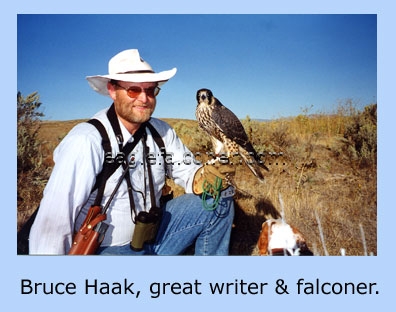 stuck in my mind. Later I purchased his masterful tome “The Hunting Falcon”, fired up by such knowledgeable and enthusiastic writing I felt I had to try and meet Bruce. It took numerous messages on our respective answering services before we managed to arrange a breakfast meeting. The problem I had in catching Bruce on the phone in person was all down to our ’best loved English falcon artist’, ‘Andrew Ellis’. Bruce had driven Andrew to Fairfield, to spend time with Charles and Patty Browning. For most of my stay in Idaho, I seemed to be one step ahead or one step behind Andrew, “I think next time we plan to visit the US. Andrew, lets check our diaries and fly there together”. Bruce and his lovely wife Evelyn and I, had an excellent time. Bruce is another of those fantastically fortunate characters, whose job seems to entail numerous helicopter rides into remote and wonderful country, looking for peregrine and prairie eyries. Working for the Idaho Department of Fish and Game as a Nongame Biologist seems to be vocation in life to aim for. Since my return to England , Bruce and I have kept up an enthusiastic correspondence, only the other day I found him in my electronic mail box. This is a dangerous escalation, cutting down from, what at best was a two week turn around by snail mail ( Inter net techno talk), to overnight communication. Where will it all end?. total 5380 words. stuck in my mind. Later I purchased his masterful tome “The Hunting Falcon”, fired up by such knowledgeable and enthusiastic writing I felt I had to try and meet Bruce. It took numerous messages on our respective answering services before we managed to arrange a breakfast meeting. The problem I had in catching Bruce on the phone in person was all down to our ’best loved English falcon artist’, ‘Andrew Ellis’. Bruce had driven Andrew to Fairfield, to spend time with Charles and Patty Browning. For most of my stay in Idaho, I seemed to be one step ahead or one step behind Andrew, “I think next time we plan to visit the US. Andrew, lets check our diaries and fly there together”. Bruce and his lovely wife Evelyn and I, had an excellent time. Bruce is another of those fantastically fortunate characters, whose job seems to entail numerous helicopter rides into remote and wonderful country, looking for peregrine and prairie eyries. Working for the Idaho Department of Fish and Game as a Nongame Biologist seems to be vocation in life to aim for. Since my return to England , Bruce and I have kept up an enthusiastic correspondence, only the other day I found him in my electronic mail box. This is a dangerous escalation, cutting down from, what at best was a two week turn around by snail mail ( Inter net techno talk), to overnight communication. Where will it all end?. total 5380 words. |
